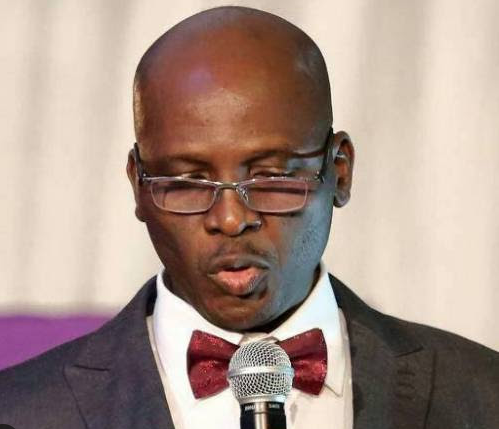Early on the fourth Saturday in September, 2023 we made some great minds to converge on air via the signals of TopRadio 90.9 FM, on our weekly radio programme, “The Vintage TalkShow…with the FAJ”. It was a special episode dedicated to honour the sudden and painful absence of a colossus of technical art and a design maestro… an intensely private individual whose works gave colour and substance to many of Nigeria’s most popular TV shows, commercials, movies, command performances, etc… – the ever charming Patrick Chike Nebo. It was simply titled “Tribute: My Impression of Pat Nebo”.
We called forth Special Voices whose paths had crossed with Nebo’s, and we had more than an hour eulogising the final stumble of an adorable iconoclast. Live in the studio was ace actor, broadcaster and producer, Yemi Shodimu, with the following folks joining us remotely: foremost actor and director, Edmond Enaibe; director, producer, actor, musician and studio owner, Yinka Akanbi; university teacher and former production manager, Dayo Haastrup; and prominent multimedia entrepreneur, director and producer, Aderemi Ogunpitan.
The inimitable producer-director and former permanent secretary/general manager of Lagos Television, Jimi Odumosu was indisposed, but sent a stirring note that was read to listeners; while ace cinematographer, Jonathan Gbemuotor, sent a three-minute pre-recorded message extolling the virtues of Nebo. However, we missed the presence of the following: filmmaker and festival director, Fidelis Duker and prolific actor Francis Onwochie – with subsequent apologies explaining their inability to honour their friends. The last invitee, foremost stage coordinator and show promoter, Edi Lawani has not explained his “no-show” even as we write.
Many people responded warmly to the episode as the guests made excellent submissions, painting a lovely, charming and inspiring picture of the ways and means of Pat Nebo. Haastrup spoke about his tenacity and fastidiousness while working with a notorious perfectionist like Tade Ogidan (major Nigerian auteur). It is hard to imagine Tade getting flustered by Pat’s aggravating attention to details! And other vignettes of filmic trivia.
The trio of Edmond, Joe and Yinka revealed interesting encounters with Pat which threw up different manifestations of an intensely creative and passionate man of ideas. Remi reminded us of their numerous trips and creative trysts from the late 1980s as they traversed the country creating vividly astounding colours and images for the benefits of clients and customers.
Let us take an excerpt from Uncle Jimi’s note: “…He in fact dragged the Producer of Sokoyokoto, and Nestlé representative to my office while I was Permanent Secretary because he insisted on me directing the Series. The programme eventually spinned off two versions in Igbo, and Hausa, after its overnight success. He even designed the LTV/LWT News Set for me for free, back then because I told him the Station didn’t have enough money to pay him. Pat was the very best. He had a thorough education in Filmmaking, not just in Production design, and Art directing. We’ve lost an industry giant, I must tell you.”
Yemi wrapped the show by drawing our attention and sustained affection towards the immediate family Pat Nebo left behind – he mentioned particularly the affable and devoted wife who stood and strove beside and on behalf of Pat Nebo until his last breath.
We also took turns to read excerpts related to Nebo from our published book, ‘Reflections: An Anthology of Thoughts on Nigerian Movie Industry’… Here are portions that reflect on the trajectory and few accomplishments of this iconic iconoclast: “Here is a strange one: you see his works and you don’t, if it’s well done. Queer? He makes the film abide by its promise; and a film fails or soars because it keeps tight to its art and production direction. If a film calls itself ‘76 (a reflection of the bloody coup intrigues of 1976 that felled a ruling military head of state) or October 1 (a throwback to issues at the sidelines of preparations for Nigeria’s Independence in 1960; you will at the very least expect the first to have military fatigues, camouflages, lifelike hardware and observance of military traditions and composure. For the latter, it is critical to have the looks, colour, fabrics, physical or architectural components and other subtleties of the late 50s.
The best man for achieving that consistency and piquancy is the man who has been at it even before the advent of the assumed industry benchmark, Nollywood: Patrick Chike Nebo. And we should know – we’ve worked with him, written about his work…on prime TV sets, major stage productions, commercial shoots, award presentations… as far back as the mid 80s.
Undoubtedly, Pat Nebo is the first name on the tongues of Nigeria’s elite filmmakers who appreciate excellence in specialisation: in most of Tunde Kelani’s works (Ti Oluwa Ni Ile trilogy – 1993, Agogo Èèwò – 2002, Arugba – 2008, etc); in virtually all of Tade Ogidan’s (Hostages – shot in 1990, Owo Blow, Diamond Ring, etc); in most of Kunle Afolayan’s (Araromire: The Figurine – 2009, October 1 – 2014, The CEO – 2016, Mokalik, and Citation – both 2019); Omoni Oboli (Being Mrs Elliot – 2014, and Okafor’s Law – 2016); and Izu Chukwu (‘76 – 2016).
Perhaps the best illustration of Nebo’s ‘illustriousity’ in Nigeria’s make-believe world is aptly captured by Ogidan’s response to our question. We asked: “Was Pat Nebo a part of Hostages in 1990?” He replied: “Yes. It was from that project that I kept encouraging him to leave NTA. I was sure that he would do well.
“He worked on turning various parts of my newly rented flat into all sorts of sets that disturbed my landlord a great deal. He made the front office in that flat (the Police Station). Turned my lovely small store to Police Cells. Built the Prison Reception in my lovely large parlour. Built the parlour of the lead boys in my passage zone. Built the Prison Visitors’ Waiting Room, and Head Warder’s bedroom from my Guest Room. Built the bedroom of the lead boys in a 2nd Bedroom. Built the Head Warder’s Office in the common area where the Parlour of the lead boys was constructed. Built the parlour of the dead corrupt Judge from my parlour; the same space where the Prison Criminals Reception was built. The only sacred room in that house was my bedroom (that didn’t have curtains at the time. The budget to buy curtains wasn’t a priority at all). We kept painting and adding dirt and stains to the walls, depending on the look needed for the set.
“The wife of the landlord was my colleague at NTA. So she believed me whenever I assured her that everything would be returned to their pristine state.
Pat eventually resigned from NTA to face a career that I assured him he would succeed in. The rest is history. He worked on several other projects with us…TV Commercials, TV drama, etc.”
Yes, after four years (from 1986), Nebo walked out of NTA, Lagos; and took the path that has now made him a reference stature for the industry in art directing and production designing.
Well, twice in over 40 years, the man who (was) 62 on June 15, 2021, broke off the design chord, to be in front of cine cameras…it must be old age (smiling). He is the cameo marriage registrar in Kunle Afolayan’s The Figurine and Colonel Aliu in the military coup film, ‘76 by Izu Ojukwu.
Some of the prime sets Nebo created in movies, include: Alero’s Symphony (2011), Phone Swap (2012), Half of a Yellow Sun (2013), The Tribunal, Omugwo (both 2017); Lionheart (2018), Crossroads (2019) and The Milkmaid (2020), the unsuccessful Nigerian entry for the Best International Feature Film category at the 93rd Academy Awards (Oscars); scripted, produced and directed by Desmond Ovbiagele.”
 Hottestgistnaija.com
Hottestgistnaija.com





